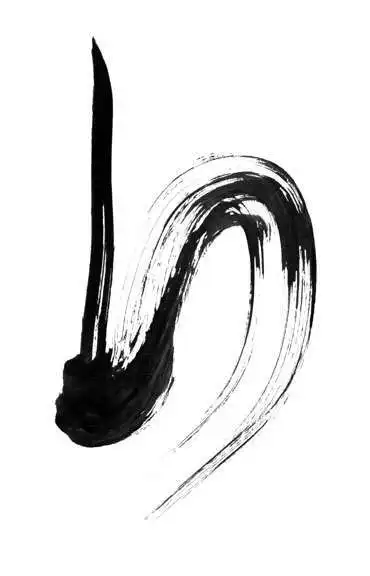Aikido InksStylized Drawings in a Shodo Calligraphy MannerI am very fond of Japanese calligraphy (shodo) and have tried it some. Now, I had the idea of doing shodo style representations of aikido techniques. You find some of them below. In Japan as well as China, using an ink brush to make expressive writing of the pictograms (kanji) is an art form all of its own. Many Japanese aikido teachers — Osensei, too — have done the same, as part of their spiritual and artistic practice. Miyamoto Musashi, the famous samurai, also recommended it. The imagery of each kanji contains its own etymology, so studying them is a fascinating exploration of Far Eastern traditional thought, which is certainly what any calligrapher would ponder when putting the brush on the paper. I've done some of that, as can be seen here and there on my webpages. On this page, though, I show some of my experiments in using the same technique and style as in shodo, but for representing aikido techniques. I let the brush move in figures that I regard as the essentials of each aikido technique. So, the ink drawings become symbols of the techniques, stylized versions of what they look like. In that way, I guess they can be said to be pictograms as well.
Ikkyo Omote Ikkyo Omote. Ink brush drawing. Click the image to see it enlarged. The ink brush continues downward and finishes with a horizontal line, which is the end pinning of the ikkyo technique. Notice that this is ikkyo omote. Ura would need to be drawn quite differently. Omote and ura are quite far apart in ikkyo, also when represented in this symbolized way. That's because ikkyo is the primary technique, lacking the particulars of the techniques that follow — nikyo, sankyo and yonkyo.
Nikyo Nikyo. Ink brush drawing. Click the image to see it enlarged. There is more happening in nikyo after the wrist lock pressure, but the ink representation stops here, since this is the most significant part of nikyo. I beet every aikido practitioner would agree.
Sankyo Sankyo. Ink brush drawing. Click the image to see it enlarged. I find the two curves to be present and quite similar in both omote and ura. So, this ink drawing can be either one.
Kokyuho Kokyuho. Ink brush drawing. Click the image to see it enlarged. The horizontal start is not exactly a straight line, or its movement would be broken when the big curve commences. It has to have a spiral quality, let's call it a prelude to the big circle to come. That's essential in making kokyuho blend with the force of the attack.
Kokyunage Kokyunage. Ink brush drawing. Click the image to see it enlarged. In that center, the flow transforms and becomes the almost explosive curve beginning drastically outwards, almost upwards, but returning at the end. Kokyunage is not throwing away the attacker, but both participating in that big curve leading both back, like coming home after a long and adventurous journey.
Iriminage Iriminage. Ink brush drawing. Click the image to see it enlarged. I see iriminage as sort of spinning uke around tori's central line, much like vine grows around the trunk of a tree. So, it's a closed circuit. Not completely, though, or the energy of the attack would remain. That's why the curve doesn't close completely.
Kaitennage Kaitennage. Ink brush drawing. Click the image to see it enlarged. I had great trouble with this drawing, making a lot of them before settling for one to post on this webpage. I'm still not that happy with it. On the other hand, I'm not completely at peace with the kaitennage technique either. It's that crossing of the line that bothers me. Conflict is hiding there. And force. Maybe I just need to practice the technique more, until I find a way to draw it in a manner I'm pleased with.
Tenchinage Tenchinage. Ink brush drawing. Click the image to see it enlarged. What the two directions open is the gap to a fountain. Once tenchinage is commenced, there's no limit to how much it can express or how far it can reach. A giant mouth opens and swallows all in its way, until it closes again. Big bang followed by a future big crunch. The simplicity of the brush strokes reveals the fundamental process the aikido technique utilizes. Like a bellows.
Stefan Stenudd
AIKIDO PRACTICEIntroductionAikido Techniques — all the basic movesAttacks in Aikido
Tantodori — knife defenseAikiken — aikido sword techniquesJo 31 Kata in four directionsAikibatto sword and staff exercisesAiki — joining energiesKi exercisesAikido Video ClipsAikido PhotosMy aikido dojo in Malmö, SwedenMy aikido seminarsAIKIDO THEORYMy Aikido BioAikido GlossaryTanden, the CenterAikido InksAikido as Self-DefenseRunning a DojoAikido is TrueOsensei and EinsteinAikiWeb ColumnsAikido Books ReviewedDie deutsche Version meines Aikido-Buches onlineAikido på svenskaAbout CookiesMy Other WebsitesCREATION MYTHSMyths in general and myths of creation in particular.
TAOISMThe wisdom of Taoism and the Tao Te Ching, its ancient source.
LIFE ENERGYAn encyclopedia of life energy concepts around the world.
QI ENERGY EXERCISESQi (also spelled chi or ki) explained, with exercises to increase it.
I CHINGThe ancient Chinese system of divination and free online reading.
TAROTTarot card meanings in divination and a free online spread.
ASTROLOGYThe complete horoscope chart and how to read it.
MY AMAZON PAGE
MY YOUTUBE AIKIDO
MY YOUTUBE ART
MY FACEBOOK
MY INSTAGRAM
MY TWITTER
STENUDD PÅ SVENSKA
|
 Aikido Principles
Aikido Principles Attacks in Aikido
Attacks in Aikido Aikibatto
Aikibatto
